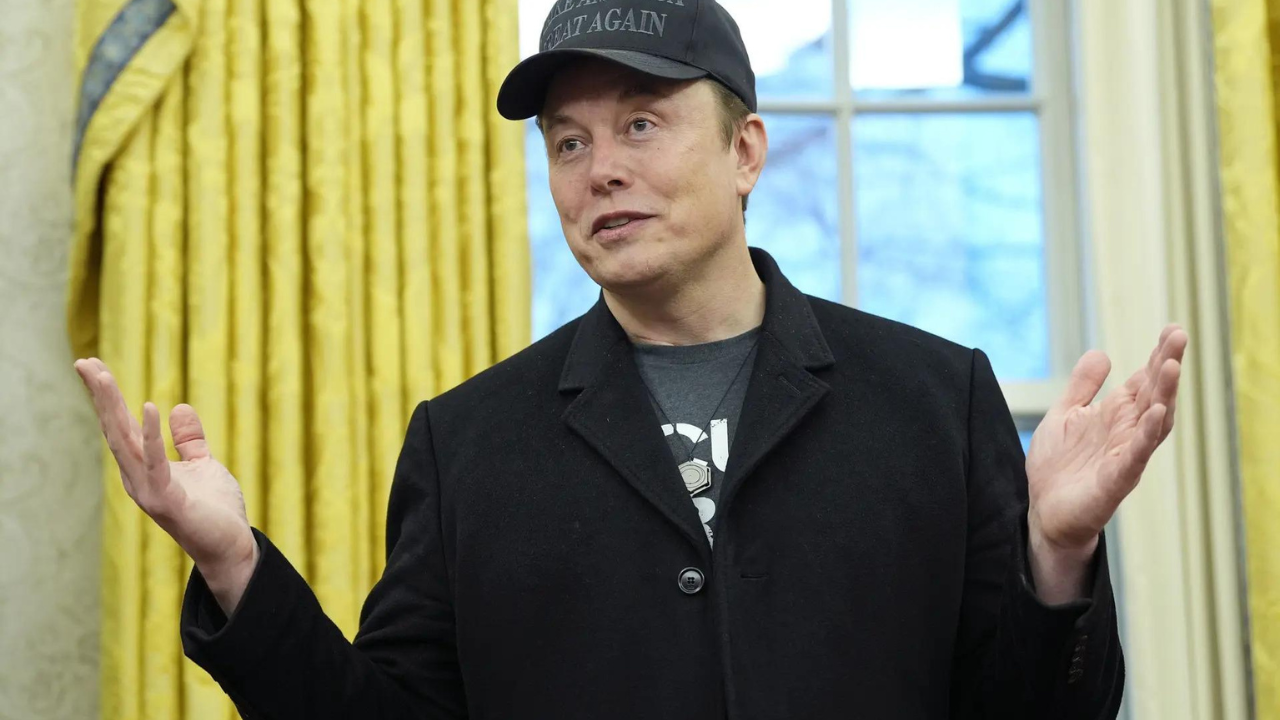World
How Donald Trump’s climate cuts will cost US taxpayers
On Donald Trump’s first day back in the White House on January 20, he signed several related executive orders that sparked radical climate policy and clean energy rollbacks. One order declared a “national energy emergency.” Another, titled “unleashing American energy,” blamed “burdensome and ideologically motivated regulations” for limiting “reliable and affordable electricity” created primarily from […]

On Donald Trump’s first day back in the White House on January 20, he signed several related executive orders that sparked radical climate policy and clean energy rollbacks.
One order declared a “national energy emergency.” Another, titled “unleashing American energy,” blamed “burdensome and ideologically motivated regulations” for limiting “reliable and affordable electricity” created primarily from oil, gas and coal.
As promised, Trump also targeted wind energy with an order that temporarily paused all offshore permits and federal leases.
Oil and gas production in the US, the world’s second-largest emitter of greenhouse gases, actually peaked under the Joe Biden administration. Average electricity prices across nearly all US states were also lower and more stable in 2024 than the previous year, according to the US Energy Information Administration.
This was not only because of low natural gas prices but also cheaper renewable energy in the grid and new battery storage capacity, due in part to decreasing renewable technology costs.
Trump’s order also attacked green energy transition policies for limiting “job creation,” despite the US renewable energy sector employing around three times more workers than the traditional fossil energy industry.
Job growth in the clean power sector rose at more than twice the rate of the “strong” overall US labour market in 2023.
The year before, renewable energy technologies, including solar panels, wind turbines, hydropower and geothermal energy systems, already made up over 84% of net new electricity generation jobs.
‘A dagger through the heart of climate-change religion’
This month, the new head of the Environment Protection Agency, Lee Zeldin, announced 31 regulatory and funding rollbacks related to climate and environment protection, and clean energy funding.
“We are living up to our promises to unleash American energy, lower costs for Americans, revitalize the American auto industry,” Zeldin said in a video posted on social media platform, X. “We are driving a dagger through the heart of climate-change religion,” he added.
In addition, he announced the termination of $20 billion (€18.3 billion) worth of clean power and climate grants issued by the outgoing Biden administration under the Greenhouse Gas Reduction Fund, also known as the “green bank.”
Zeldin highlighted “programmatic fraud, waste, and abuse” when announcing that the EPA had frozen the funding pending a review.
But on Tuesday, a US federal judge said the EPA’s “vague and unsubstantiated assertions of fraud are insufficient.”
On these grounds, the judge blocked the agency from terminating $14 billion dollars in green grants earmarked for three climate groups who had sued the EPA and Zeldin.
Tax dollars to pay massive climate damages. When Trump withdrew the US from the Paris Climate Agreement earlier this year, he sparked fears that the country’s failure to reduce emissions could severely hinder efforts to limit global heating.
This would also result in major costs for citizens in the US and beyond. A report by business advisors, the Boston Consulting Group predicts that if temperatures increase by 3 degrees Celsius by 2100 — double the 1.5-degree target set in Paris — such warming would “reduce cumulative economic output by 15% to 34%” by the end of the century.
In the last decade alone, climate-related extreme weather events have cost the global economy more than $2 trillion, according to a recent report by the International Chamber of Commerce.
The January Los Angeles wildfires that caused widespread destruction and have been linked to human-made climate change alone caused property and capital damages of up to $164 billion.
Boston Consulting note that the net cost of inaction could be as high as 27% of cumulative GDP globally, which is enough to otherwise eradicate extreme poverty around the world.
Climate rollbacks to spark job losses and economic decline
Corey Bradshaw, a professor of global ecology at Flinders University in South Australia, says the Trump administration claims that its climate cuts will improve economic prosperity are false. Disincentivizing the green manufacturing boom will only result in job losses and economic decline for American consumers, he said.
“Their cost of living will grow and their income opportunities will decline,” he told DW.
Two years after the 2022 Inflation Reduction Act (IRA) triggered the flow of hundreds of billions of dollars into clean energy technologies, the sector has accounted for more than half of the total US private investment growth, according to a 2024 report by the Clean Investment Monitor (CIM) — which tracks public and private funding of climate technologies in the US.
The fastest growth was in manufacturing clean energy and transportation technology, which totalled $89 billion in the two years after the IRA was legislated — more than four times the $22 billion invested in the two years prior to the Biden administration’s flagship 2022 law to address climate change.
Republican states have been significant beneficiaries of this clean energy largesse. Nearly 60% of the projects announced since 2022 are in the party’s congressional districts.
Georgia alone gained over 43,000 green jobs and more than $30 billion in renewables investment since the passage of the IRA. More than 400,000 new clean energy jobs were created nationally.
By 2024, the US power grid had added more capacity from solar energy than from any other source in more than two decades.
Sylvia Levya Martinez, a solar analyst for US energy consultants Wood Mackenzie, which co-authored a report announcing the record solar uptake, warned that the boom could be quickly reversed, however.
“Last year’s record-level of installations was aided by several solar policies and credits within the Inflation Reduction Act that helped drive interest in the solar market,” she said in a statement. “If any of these policies were eliminated or significantly altered, it would be very detrimental to the industry’s continued growth.”
Trump’s climate revolt to be held up in the courts?
Meanwhile, David Bookbinder, director of law and policy at the Environmental Integrity Project, a pro-climate non-profit, believes that efforts to dismantle climate and environmental protection will be held up in the courts.
“The EPA cannot roll those regulations back without a lengthy process,” he said, noting that during the first Trump administration, the EPA lost most of its anti-climate court cases due to failure to follow procedural rules.
Corey Bradshaw cautions, however, that while Trump‘s attempted climate rollbacks are “illogical” and amount to support for “a dying fossil fuel industry,” any delay to urgent emission cuts will quickly “retard any climate gains.”
World
Trump’s Tariffs Shake Global Markets as Netanyahu Heads to Washington: What’s Happening Today
April 7, 2025 – It’s a wild Monday morning, folks! Global stock markets are in a tailspin, and it’s all thanks to President Donald Trump’s bold tariff moves. If you’ve been scrolling the news or X lately, you’ve probably seen the headlines: Trump’s latest trade war tactics are hitting hard, and world leaders are scrambling […]

April 7, 2025 – It’s a wild Monday morning, folks! Global stock markets are in a tailspin, and it’s all thanks to President Donald Trump’s bold tariff moves. If you’ve been scrolling the news or X lately, you’ve probably seen the headlines: Trump’s latest trade war tactics are hitting hard, and world leaders are scrambling to respond. Today, all eyes are on Washington, where Israeli Prime Minister Benjamin Netanyahu is set to meet with Trump in a high-stakes sit-down. Let’s break it down in a way that feels less like a lecture and more like a chat over coffee.
Markets Are Freaking Out—Here’s Why
Imagine waking up to find your grocery bill doubled overnight. That’s basically what’s happening worldwide as Trump’s new tariffs kick in. We’re talking a blanket 10% tax on imports that’s already live, with even steeper hikes—like 20% or more—rolling out soon. Countries like Germany, China, and Canada aren’t thrilled, and their stock markets are showing it.
The Dow plunged over 2,200 points last week, and the S&P 500 lost a jaw-dropping $5 trillion in value in just two days. Yikes, right? Analysts say these “reciprocal tariffs” (Trump’s term for taxing imports to match what other countries charge the U.S.) could spark a recession if things don’t cool off. For everyday people, this might mean pricier cars, clothes, and even coffee—ouch!
Netanyahu’s Dash to D.C.: Tariffs, Hostages, and More
Meanwhile, Netanyahu’s jetting over from Budapest to be the first foreign leader to face Trump since this tariff chaos erupted. Why the rush? Israel’s feeling the pinch too, with a 17% tariff slapped on its exports to the U.S. Netanyahu’s hoping to sweet-talk Trump into easing up, especially since Israel just ditched all tariffs on American goods to play nice. But it’s not just about trade.
They’re also tackling big stuff like the Gaza war, where Israel’s fighting Hamas and trying to free hostages, plus tensions with Iran and the International Criminal Court (which has an arrest warrant out for Netanyahu—drama!). Picture this meeting as a high-stakes poker game—everyone’s got cards to play, and the stakes are sky-high.
What People Are Saying
Over on X, folks are buzzing. Some are cheering Trump’s tough-guy approach, saying it’ll bring jobs back to the U.S. Others? Not so much—they’re worried about empty wallets and a global mess. Netanyahu’s trip has fans and critics alike chiming in, with many wondering if he’ll score a win for Israel or just stir the pot. Trending chatter aside, one thing’s clear: this is a story with legs, and it’s only Monday!
What’s Next?
Trump’s team is brushing off the market panic, with advisers like Peter Navarro predicting a “bullish boom” once the dust settles. Skeptics aren’t so sure, pointing to retaliation from heavyweights like China (hello, 34% tariffs on U.S. goods starting April 10). Netanyahu’s visit could set the tone—will Trump budge, or double down? For now, grab your popcorn (and maybe check your budget), because this trade war rollercoaster is just getting started.
Stay tuned—we’ll keep you posted as this unfolds!
World
Shocking ‘White Lotus’ Season 3 Finale Recap: Twists, Turns, and Unforgettable Moments
Dive Into the Explosive Conclusion of HBO’s Hit Series Set in Thailand The third season of The White Lotus wrapped up on April 6, 2025, with a finale that left fans buzzing. This supersized episode, airing on HBO and streaming on Max, delivered a rollercoaster of emotions, tying up loose ends while throwing in some […]

Dive Into the Explosive Conclusion of HBO’s Hit Series Set in Thailand
The third season of The White Lotus wrapped up on April 6, 2025, with a finale that left fans buzzing. This supersized episode, airing on HBO and streaming on Max, delivered a roller coaster of emotions, tying up loose ends while throwing in some jaw-dropping surprises. Whether you’re a die-hard fan or just catching up, here’s a fresh take on how it all went down at the luxurious Thailand resort.
This season, creator Mike White took us on an eight-episode journey—longer than the previous six- or seven-episode runs—giving us more time to soak in the slow, meditative vibe of the high-end retreat. But don’t let the relaxed pace fool you: the finale packed plenty of drama, from steamy encounters to violent twists, keeping viewers hooked until the very end.
One character who stole the spotlight this season was Gaitok, the front gate security guard played by Tayme Thapthimthong. While some fans felt the resort staff took a backseat compared to Seasons 1 and 2, Gaitok’s arc brought him front and center. After suspecting a fellow employee, Valentin (Arnas Fedaravicius), and his Russian buddies of pulling off a heist earlier in the season, Gaitok’s story reached a boiling point in Episode 7. Torn between self-doubt and his dream of becoming a bodyguard for the resort’s wealthy owners, Jim (Scott Glenn) and Sritala Hollinger (Patravadi Mejudhon), his journey added depth to the finale’s chaos.
Then there’s Belinda, portrayed by Natasha Rothwell, who bridges this season back to Seasons 1 and 2 through her ties to Tanya and Greg (now going by Gary). In the finale, Belinda and her son Zion strong-arm Greg into coughing up $5 million. She quickly ditches her plan to open a spa with her Thai lover, Pornchai, opting for the cash instead. It’s a bittersweet win—Belinda’s windfall feels deserved after Tanya’s broken promises, but her unease during the deal, especially when Zion brushes off Greg’s shady history with a Langston Hughes quote, hints at lingering tension.
The finale didn’t skimp on surprises either. Some characters walked away with happy endings, while others met fates that left us reeling. True to White Lotus form, the twists kept coming, ensuring no one could predict the outcome until the credits rolled. Did it answer every question? Not quite—but that’s part of the show’s charm.
Season 3 stirred up plenty of chatter online. Was the pacing too slow? Did the Thai characters get their due? And what about all that wild incest drama—did it cross a line? Love it or hate it, this season’s bold choices sparked endless debates, proving The White Lotus still knows how to get under our skin.
If you haven’t caught the finale yet, it’s streaming now on Max alongside the full season. With its mix of dark humor, stunning visuals, and standout performances, this conclusion cements The White Lotus as must-watch TV. What did you think of the ending_spinner? Drop your thoughts below and let’s unpack those final moments together!
World
Saudi Arabia Shocks Travelers: Temporary Visa Suspension Hits India and 13 Nations
New Visa Restrictions Aim to Ensure a Safer Hajj Season Saudi Arabia has rolled out a surprising new policy, putting a temporary halt on certain visas for citizens of 14 countries, including India. This move, effective immediately as of April 6, 2025, targets Umrah, business, and family visit visas, with the suspension set to last […]

New Visa Restrictions Aim to Ensure a Safer Hajj Season
Saudi Arabia has rolled out a surprising new policy, putting a temporary halt on certain visas for citizens of 14 countries, including India. This move, effective immediately as of April 6, 2025, targets Umrah, business, and family visit visas, with the suspension set to last until mid-June, aligning with the end of this year’s Hajj pilgrimage. The decision reflects the Kingdom’s efforts to tackle overcrowding and enhance safety during one of the world’s largest religious gatherings.
The Saudi government is tightening the reins to stop people from misusing Umrah or visit visas to sneak into Hajj without proper authorization. Last year’s pilgrimage saw a tragic loss of over 1,000 lives due to extreme heat and overcrowding, with many victims being unauthorized attendees who entered on non-Hajj visas. To prevent a repeat, authorities are cracking down, limiting visa options and enforcing stricter controls.
Travelers from India, Pakistan, Bangladesh, Egypt, and a handful of other nations—13 identified so far, with one still unnamed—will feel the impact. Until April 13, short-term visas like single- and multiple-entry business, tourist, and family visit permits will still be issued. After that, no new visas of these types will be granted until the Hajj season wraps up. Overstaying or attempting Hajj without official permission could slap violators with a hefty five-year entry ban.
Crown Prince Mohammed bin Salman has personally pushed for these tougher measures, aiming to make Hajj safer and better organized for registered pilgrims. The shift has left many would-be visitors, from business travelers to families hoping to reunite, scrambling to adjust plans. For now, only single-entry visas with a 30-day cap are on the table for affected countries, a stark change from the flexibility of the previous multiple-entry options.
This isn’t the first time Saudi Arabia has adjusted its visa policies to manage pilgrimage crowds, but it’s a bold step that’s sparking conversations worldwide. Whether you’re planning a trip for Umrah, business, or to see loved ones, keep an eye on official updates—these restrictions could reshape travel to the Kingdom for months to come. Stay tuned as we await a formal statement from the Saudi Foreign Ministry to clarify the full scope of this policy shake-up.
-

 india2 years ago
india2 years ago“Major Crash of Sukhoi Su-30 and Mirage 2000 Fighter Jets in Madhya Pradesh”
-

 Sports2 years ago
Sports2 years agoWFI meetings on April 16, elections likely to be discussed
-

 india1 year ago
india1 year agoPM Modi Meets Deve Gowda for Seat Sharing Talks
-

 india1 year ago
india1 year agoBengaluru: False threat to bomb Raj Bhavan
-

 india2 years ago
india2 years ago“AIMIM to Contest 50 Seats in Upcoming Telangana Assembly Elections”
-

 Entertainment1 year ago
Entertainment1 year agoAnant Ambani: Controversy at the Ambani Pre-Wedding Bash
-

 Entertainment2 years ago
Entertainment2 years agoRajinikanth is Moideen Bhai in ‘Lal Salaam’
-

 Videos2 years ago
Videos2 years agoBidar News : Press Meet Organized By Zilla Kannada Sahitya Parishad










